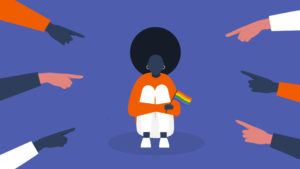
It’s a lazy afternoon, you’re binging one TV show after another. On the screen enters an actor, his lips pursed in a pout, hands on his hip, an eyebrow raised, shiny leather pants paired with a colorful sequined jacket. His accent has a strange lilt to it, and he says ‘OH EM GEE’ instead of a pedestrian ‘oh my god’. Your line of thought, like almost everyone else’s has directed you to form one singular opinion, just as the show-makers intended – He’s gay.
And now, in 2020, you wonder; why did I think so?
The portrayal of LGBTQIA+ characters is now no longer just for comic relief or token allyship, improving significantly with complex characters like Alex Vause in ‘Orange Is the New Black’ and Connor Walsh in ‘How to Get Away With Murder’ being introduced. While queer representation has diversified and deepened, it’s important for us to assess whether or not we’re moving in the right direction in portraying the community. More than just visibility, it’s important that we focus on the right kind of visibility.
Queer people, when watching TV shows, often see themselves portrayed in a largely artificial, monotonously positive light – settled, successful and accepted by society with open arms, avoiding the task of actually fleshing out their backstories. While it may be easier to depict queer characters as having no more issues than their straight counterparts, the reality remains that most queer people suffer in ways unique to their community. They are shunned by their families, discriminated against (in employment, housing, healthcare), and forced to suffer an onslaught of slurs and derogatory speech from even strangers on the street (‘dyke’, ‘meetha’, ‘chakka’ to name a few).
The married life of homosexual couples is a huge aspect of queer representation that still remains grossly under-represented. In some cases, like ‘Dark’, film-makers compromise by depicting bisexual characters as being committed to a member of the opposite sex but going on to have an extra-marital affair with someone of the same sex, a la Doris Tiedemann’s involvement with Agnes Nielsen.
Television largely propagates heterosexuality as the ‘norm’ and those who do not conform to this mold are distinguished superficially by just their appearance and mannerisms.
Gay men are stereotyped as effeminate, sassy shopaholics never caught sans makeup and with fingers perpetually busy fixing their hair or being manicured (recent exceptions include Captain Holt of ‘Brooklyn 99’ fame, who decimated this near-immortal stereotype).
Lesbians are stereotyped as decidedly masculine, wearing baggy clothes, hair cropped short, no trace of makeup, voices made deep and baritone to accommodate the ‘butch’ stereotype (‘femme’ who?).
Often, queer representation includes either overtly sexual characters or those with no sexual aspect to them at all. TV shows with either representation leave out the tender, romantic, and emotionally intense components of same-sex romance while exploring every aspect of heterosexual love.
While these stereotypes largely do exist, we are moving forward in our ways of representation by including shows made by the queer community for the queer community, granting the much-needed multi-dimensional view of LGBTQIA+ individuals. TV Shows like Queer Eye, Feel Good and The L- Word and movies like Love Simon, Alex Strangelove, and Moonlight created a buzz for this very reason; queer people were no longer an opportunity for a cheap joke or trope.
These shows and movies are trying to take a step forward without reducing gay men to dolled-up divas, fetishizing lesbians or bisexual women, or degrading trans individuals to anything less than human. They’ve worked hard to highlight the key problems of the queer community as well as do away with the trope-deep representation seen so far.
Who would’ve thought you would end up with a Watch-List by the end of this article to continue your afternoon binging session?
Written by Asma Abidin for MTTN
Edited by Mihika Antonia Dean for MTTN
Featured Image by @yannathesupaflowa
Artwork by @nadia_bormotova

Leave a Reply
You must be logged in to post a comment.